Cucumbers
BackCucumbers are part of the cucurbit vine family which includes pumpkins, zucchini, squash, watermelons and rockmelons. They’re most commonly eaten raw in salads but can also be pickled or made into tasty relishes and dips. All parts of the cucumber are edible but some varieties have a thick bitter skin which is better peeled off.
Cucumbers come in many shapes and sizes and the variety you grow will depend on whether you plan to pickle them (gherkins) or use them in salads. Salad varieties are often chosen because they are burpless and easier on the digestive system, or because they have a milder flavour with reduced bitterness. Why not try growing a few different types and see what your favourite variety is?
How To Grow Cucumbers
Cucumbers are a warm season annual which should be grown in a sunny spot with protection from winds (either cold or hot). They love rich soil full of organic matter so improve yours before planting by working in compost and manures. Boost calcium levels at the same time with a dose of dolomite or lime.
If left to their own devices plants will spread out over the ground so either choose a spot with plenty of space or install a trellis before planting and train them upwards instead. This will keep the fruit cleaner, make harvesting easier and give you more space in the veggie patch for other plants.
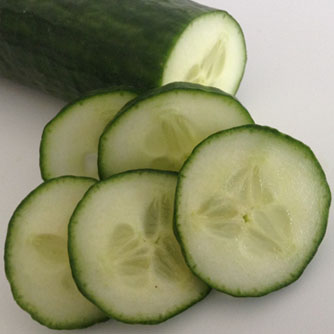
Sliced cucumber ready for eating!
Seeds can be sown direct in the soil or in punnets and transplanted later on. If sowing directly wait until frosts have finished and the soil has warmed up. Plant 3-4 seeds in a mound to aid drainage and then thin out keeping the two strongest seedlings. Seedlings should appear in a week or so and will benefit from an application of OCP eco-seaweed to get them off to a great start.
Growing in punnets can give you a head start because seeds can be planted earlier when frosts are still present but the punnets are in a protected location. Just remember they’ll still need warm soil to germinate so either use a heat mat or put them somewhere warm, like the top of the water heater, until germination occurs. Plant out when frosts are finished or if you can’t wait until then plant sooner and cover them each night until frosts have passed.
Remember to mulch around seedlings to retain soil moisture, keep weeds at bay and help reduce some fungal problems.
As the vines start to grow, pinch out the growing shoot to encourage more branching and ultimately more flowering and fruiting. Ensure regular watering as cucumbers like a lot of moisture. Water in the morning if possible to avoid fungal problems.
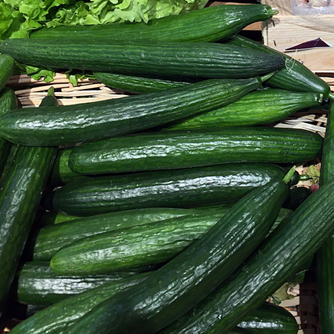
Extra long telegraph cucumbers
Sowing Guide for Cucumbers
Cucumbers can be grown just about anywhere in Australia as long as they have warmth and protection from cold winds and frost. In cool areas the soil is still cold in spring so early plantings are best started in punnets to achieve better germination.
| Growing Zone | Sowing Time |
| Cool Zones | Spring, Summer (early) |
| Mediterranean Zones | Spring, Summer |
| Warm & Temperate Frost Free Zones | Spring, Summer, Autumn (early) |
| Tropical & Subtropical Zones | Spring, Summer, Autumn, Winter |
Fertilising Cucumbers
Cucumbers will perform best when grown in rich soil and are fed regularly. Every two weeks apply OCP eco-seaweed and OCP eco-aminogro to build strong healthy plants which fruit well and are more resistance to diseases.
Midway through the season you can boost the soil with another dose of dolomite or lime and more compost/manure especially if you’ve got poor soil.
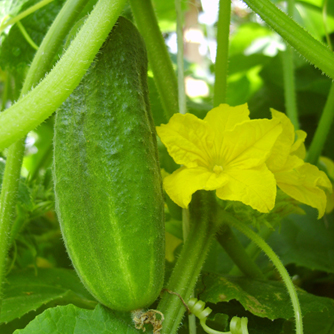
Cucumber flowers and developing fruit
Pollination Of Cucumbers
Cucumbers produce separate male and female flowers with pollination relying on bees travelling between the two and transferring pollen. Low bee numbers will mean less cucumbers to harvest so follow our tips to attract more bees into your garden.
Hand pollination is another option and is best done in the morning. Simple pick off a male flower (they have a long skinny stem under the flower) and remove the petals to expose the stamen in the centre which holds the pollen. Then rub the stamen onto the centre of female flowers (these have a swelling under the flower) to transfer the pollen. If you’re unsure about male versus female flowers then use a small soft paintbrush and just dab it into the centre of all the open flowers. Sooner or later you’ll pick up some pollen and transfer it about the place
Harvesting Cucumbers
Cucumbers take about 8-10 weeks before you can harvest depending on the variety and growing conditions. Some varieties will produce prickly fruit so take care when harvesting them. Make sure you cut the cucumber stalk from the vine with secateurs to not damage the main plant.
Cucumbers for gherkins/pickling should be harvested when they are 5-10cm long and for salads approx 15-20cm long. Early and regular picking promotes more flowering. Leaving cucumbers too long on the vine will increase the toughness of their skin and the risk of bitterness.

Short and sweet Lebanese cucumbers
Pests and Diseases of Cucumbers
Unfortunately there are many things which can go wrong with cucumbers. Here are the top problems:
- Snails and slugs - seedlings are particularly vulnerable to being attacked by these pests. Regularly scatter OCP eco-shield pellets around to keep seedlings safe.
- Aphids, whitefly and mites – these are quickly brought under control with a spray of OCP eco-oil.
- Powdery mildew – this fungal disease commonly attacks cucumbers and can be controlled with OCP eco-fungicide. If it’s late in the growing season the disease will most likely reappear as the plants are coming to the end of their lifespan. Spraying will delay things and extend your harvest window but ultimately plants will succumb to the disease.
- Damping off – this is when seedlings rapidly collapse and die due to various soil borne pathogens. Apply regular doses of OCP eco-seaweed to strengthen the plants cells against attack and increase the organic material in the soil to encourage a better balance of healthy soil microbes.
- Poor pollination – can be due to cool weather, excessive heat/humidity/rainfall, or a lack of bees. You can’t control the weather but you can attract more bees into the veggie patch or try hand pollinating.
- Fruit drop – young fruit which fails to develop could be a result of poor pollination, incorrect levels of moisture or fungal diseases. Check your watering as plants are probably drying out and apply OCP eco-seaweed regularly to reduce plant stress.
- Leaf scorch – strong winds and dry conditions will easily damage the leaves. Keep moisture up to the plants and again use OCP eco-seaweed to reduce plant stress. Next time plant in a more sheltered spot.
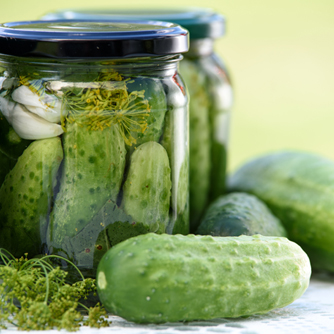
Pickled cucumbers are better known as gherkins
- Curling fruit – not all fruit will develop perfectly straight like you see in the supermarket but this is normal. Luckily they all taste the same, even the bent ones
- Nematodes – poor plant growth especially close to harvest and lumps on roots indicates that nematodes have infested the roots. Usually worse in sandy soils and hotter climates. Treat soils with OCP eco-nemguard at planting time and again 4-6 weeks later to kill nematodes before they infest roots. Increasing organic content in the soil (composts and manures) and practicing crop rotation can also help to reduce nematode numbers.
- Viruses – yellowing or curling leaves, stunted growth and reduced yields could mean your plant has been infected with a virus. There are several which are spread by sap sucking pests (like aphids and whitefly). Once infected you can’t eradicate the virus so plants should be removed. In future be more vigilant at controlling sap sucking pests with OCP eco-oil.
- Other diseases – there are numerous diseases which can attack cucumbers and result in plant death, stunted growth or random spots/blotches on leaves and fruit. Sometimes a copper may improve the situation but usually they are difficult or impossible to control so you need to take preventative measures. Always practice crop rotation and remove infected foliage quickly. Regular doses of OCP eco-seaweed and OCP eco-aminogro will go a long way to keeping plants in peak health. And remember to keep them well watered during hot weather.
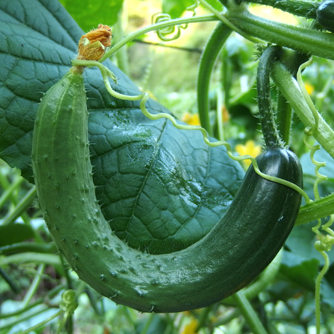
Sometimes a cucumber will curl but this is normal


